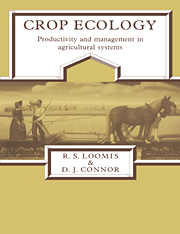Book contents
- Frontmatter
- Contents
- Preface
- Part I Farming systems and their biological components
- Part II Physical and chemical environments
- Part III Production processes
- Part IV Resource management
- 12 Soil management and sustainability
- 13 Strategies and tactics for rainfed agriculture
- 14 Water management in irrigated agriculture
- 15 Energy and labor
- 16 Analysis of wheat–sheep farming in southern Australia
- 17 Mixed farming in the North American Corn Belt
- 18 Towards an uncertain future
- References
- Species list
- Conversions and constants useful in crop ecology
- Index
17 - Mixed farming in the North American Corn Belt
from Part IV - Resource management
Published online by Cambridge University Press: 05 June 2012
- Frontmatter
- Contents
- Preface
- Part I Farming systems and their biological components
- Part II Physical and chemical environments
- Part III Production processes
- Part IV Resource management
- 12 Soil management and sustainability
- 13 Strategies and tactics for rainfed agriculture
- 14 Water management in irrigated agriculture
- 15 Energy and labor
- 16 Analysis of wheat–sheep farming in southern Australia
- 17 Mixed farming in the North American Corn Belt
- 18 Towards an uncertain future
- References
- Species list
- Conversions and constants useful in crop ecology
- Index
Summary
INTRODUCTION
Farming systems of the North American Corn Belt contrast sharply with Victorian wheat-sheep farms. Cropping in an extensive area centered on the states of Iowa, Illinois, and Indiana (Fig. 17.1) is dominated by maize and soybean. Leguminous forages, oat, wheat, and pasture are also found within the region. The abundance of superior feed grains and forages leads to a strong emphasis on production of swine, beef cattle, and dairy products. The climate is too cold and the growing season too short for subtropical crops such as rice, cotton, sugarcane, and citrus. A number of fruits and vegetables can be grown but competing regions such as California generally produce those with higher quality and with less risk and less cost.
Much of the original vegetation in this region was tall-grass prairie and oak savannah on level to gently undulating glacial till, loess, and alluvium. When farming began in 1830, tall-grass prairies presented a rather hostile environment. Traditional wooden plows were inadequate for breaking sod and shortages of wood for fencing and fuel were a concern. John Deere's steel plow (1840) pulled by heavy oxen opened the land; invention of a practical barbed wire (1870) allowed development of mixed farming with livestock; and invention of elevator grain storage buildings facilitated handling and shipping of grains by rail and barge. Technological change has continued to be a fundamental feature of Corn-Belt farming. Hybrid maize resistant to stalk rot (1930), soybean as a new crop (1935), low-cost ammonium fertilizer (1950), herbicides (1950), and chisel plows (adopted in the 1970s) are recent innovations that have brought dramatic change to crop production.
- Type
- Chapter
- Information
- Crop EcologyProductivity and Management in Agricultural Systems, pp. 450 - 474Publisher: Cambridge University PressPrint publication year: 1992



